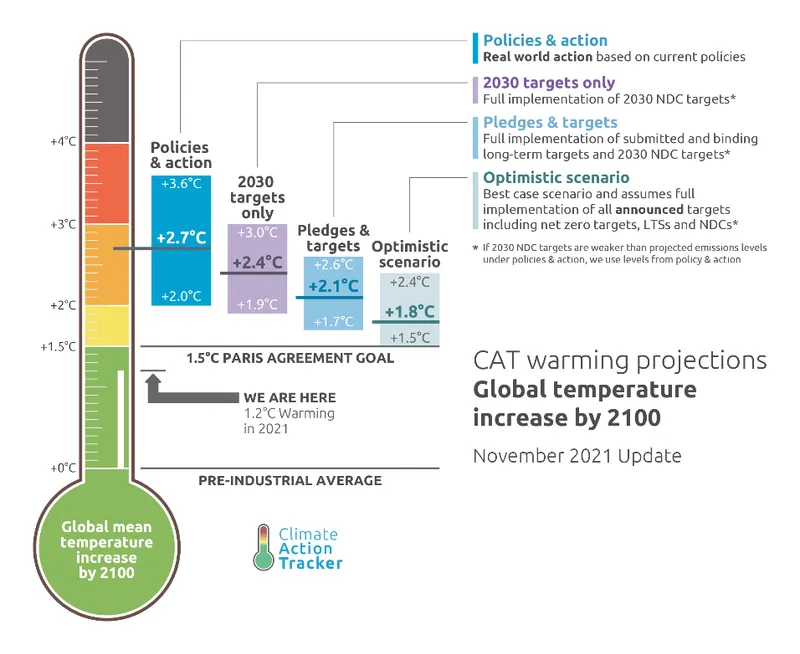Technology can fast pace Climate Action
There is a growing recognition that innovation in tech is critical for climate action, and gains from new technologies can be widespread.
Today’s world faces an existential crisis of ‘Human Induced Global Warming’. As of 2021, the planet had already warmed up an average 1.20C from pre-industrial era of 1870s. The annual carbon dioxide (CO2) emission has grown over 70 times from pre-industrial era to 36.4 giga tonnes (gt) (2019).
According to the Inter-Governmental Panel on Climate Change (IPCC),to limit the devastating impact of climate catastrophe, we should limit global warming to 1.50C, in other words, we need to bring down the yearly emission to 18.22 gt by 2030.
The way forward: carbon decoupled growth

Source: Climate Action Tracker
The world needs a clear step-by-step roadmap to avoid the devastating impacts of climate change within the mid of this century. The best way forward is to have a growth system designed fully on technological advances that de-couples growth and carbon, enabling drastic reduction in emissions.

Source: Climate Action Tracker
Technological Intervention & Innovation for Climate Action
Technological innovations can facilitate a full spectrum of possibilities for climate action. With the rapid advancement of information technology and IoT based artificial intelligence systems getting widely deployed for businesses and government operations, technology can enable an optimised climate action.
Any successful strategy to reduce greenhouse gas (GHG) emissions significantly will require us to not only deploy the low-emission technologies that are available today, but also to foster innovation on new technologies that are needed.
Technology innovations can help replace current GHG-intensive resources like fossil fuels (oil, gas and coal) with newer technologies that emit fewer or no greenhouse gases.
There are five board processes that can help tighten the global efforts towards a successful climate action that leads to ‘Net Zero’ GHG emission levels in three decades. And technology can enable these processes at every step.
1. Measurement & Reporting
Technology can help fool-proof measurement systems to effectively inventorize all the major sources of emissions of the scientifically known potent GHGs. Technology can help ensure a higher degree of reliability on measuring and reporting which is the most important foundation for all the efforts towards the abatement of this existential crisis.
Registry systems of GHGs emissions as well as carbon trading (cap and trade) systems across corporations and political boundaries can also be made more effective and transparent.
2. Improvement of system operations
Technological interventions can offer a host of highly efficient solutions for climate action - be it in renewable energy integration to regional and country grid, or enhanced transmission and distribution system design and retrofit.
New or improved technologies can enable vehicles, machinery, and appliances to be more energy efficient.
3. Application of Blockchain Technology
The application of blockchain technology in the energy industry has potential to provide a fully decentralised energy system enabling a fully transparent communication facility between producer and consumer.
In this present era of decarbonization of energy sector, where the economy is transitioning from petro to electro, blockchain technology can help strengthen direct relation between consumer and producer at the market, enhancing a higher degree of transparency and autonomy.
The operational features of the carbon trading market can also fit well into the blockchain mechanism.
4. Energy Transition, Efficiency Improvements and Sustainable Consumption
The world needs to change the way it develops energy utilising natural resources. Energy transition from petro economy to electro economy may be the right path towards our quest for a sustainable world, which is resource efficient and smart.
Nature-based solutions that conserve local resources and maintain bio-diversity will provide us with solutions that align better with mother nature.
New technologies can create or utilise alternative energy carriers and chemicals that emit less GHG per unit of useful product or service, and create alternative ways of providing goods and services that are less GHG-intensive and are also sustainable.
5. Abatement planning and management
Using technology to identify the key sources of emissions and consequently implement measures to reduce them can help abate emissions. AI and IoT technology can enable insights from real-time data to better predict process emissions.
By analysing and learning through data from multiple processes, IoT can refine the performance evaluation of abatement measures and optimise emission predictions. Technology can also help track the performance and progress of abatement programmes.
The need to fast pace technology interventions
Technology innovation plays a critical role in addressing the problems of global climate change—arguably the most pressing environmental challenge we presently face today.
While the links between innovation and attainment of environmental goals has become a subject of growing interest, achieving climate change goals through technology interventions will require policy drivers, government support and an infusion of financial and human resources to support each stage of the technological-change process.
The role of government policies is especially critical in fostering innovations that address the problem of climate change.
Deploying technology innovations for climate action will enable an integrated action plan to measure real-time emission and offset it immediately. This will enable countries to not only talk the talk but also walk the walk and transparently meet their net-zero targets.
Edited by Anju Narayanan
(Disclaimer: The views and opinions expressed in this article are those of the author and do not necessarily reflect the views of YourStory.)







